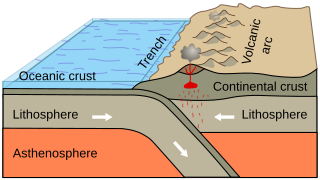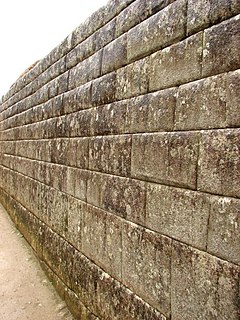
Medieval fortification refers to medieval military methods that cover the development of fortification construction and use in Europe, roughly from the fall of the Western Roman Empire to the Renaissance. During this millennium, fortifications changed warfare, and in turn were modified to suit new tactics, weapons and siege techniques.

Masonry is the building of structures from individual units, which are often laid in and bound together by mortar; the term masonry can also refer to the units themselves. The common materials of masonry construction are brick, building stone such as marble, granite, and limestone, cast stone, concrete block, glass block, and adobe. Masonry is generally a highly durable form of construction. However, the materials used, the quality of the mortar and workmanship, and the pattern in which the units are assembled can substantially affect the durability of the overall masonry construction. A person who constructs masonry is called a mason or bricklayer. These are both classified as construction trades.

Stonemasonry or stonecraft is the creation of buildings, structures, and sculpture using stone as the primary material. It is one of the oldest activities and professions in human history. Many of the long-lasting, ancient shelters, temples, monuments, artifacts, fortifications, roads, bridges, and entire cities were built of stone. Famous works of stonemasonry include the Egyptian pyramids, the Taj Mahal, Cusco's Incan Wall, Easter Island's statues, Angkor Wat, Borobudur, Tihuanaco, Tenochtitlan, Persepolis, the Parthenon, Stonehenge, the Great Wall of China, and Chartres Cathedral.

Earth materials include minerals, rocks, soil and water. These are the naturally occurring materials found on Earth that constitute the raw materials upon which our global society exists. Earth materials are vital resources that provide the basic components for life, agriculture and industry. Earth materials can also include metals and precious rocks.

The Mendip Hills is a range of limestone hills to the south of Bristol and Bath in Somerset, England. Running from Weston-super-Mare and the Bristol Channel in the west to the Frome valley in the east, the hills overlook the Somerset Levels to the south and the Chew Valley and other tributaries of the Avon to the north. The hills give their name to the local government district of Mendip, which administers most of the area. The higher, western part of the hills, covering 198 km2 (76 sq mi) has been designated an Area of Outstanding Natural Beauty (AONB), which gives it a level of protection comparable to a national park.

Dry stone, sometimes called drystack or, in Scotland, drystane, is a building method by which structures are constructed from stones without any mortar to bind them together. Dry stone structures are stable because of their construction method, which is characterized by the presence of a load-bearing façade of carefully selected interlocking stones.

Cobblestone is a natural building material based on cobble-sized stones, and is used for pavement roads, streets, and buildings.

An oast, oast house or hop kiln is a building designed for kilning (drying) hops as part of the brewing process. They can be found in most hop-growing areas and are often good examples of vernacular architecture. Many redundant oasts have been converted into houses. The names oast and oast house are used interchangeably in Kent and Sussex. In Surrey, Hampshire, Herefordshire and Worcestershire they are called hop kilns.

Clunch is a traditional building material of chalky limestone rock used mainly in eastern England and Normandy. Clunch distinguishes itself from archetypal forms of limestone by being softer in character when cut, such as resembling chalk in lower density, or with minor clay-like components.

Ashlar is finely dressed stone, either an individual stone that has been worked until squared, or a structure built from such stones. Ashlar is the finest stone masonry unit, generally rectangular cuboid, mentioned by Vitruvius as opus isodomum, or less frequently trapezoidal. Precisely cut "on all faces adjacent to those of other stones", ashlar is capable of very thin joints between blocks, and the visible face of the stone may be quarry-faced or feature a variety of treatments: tooled, smoothly polished or rendered with another material for decorative effect.

Rustication is a range of masonry techniques used in classical architecture giving visible surfaces a finish texture that contrasts with smooth, squared-block masonry called ashlar. The visible face of each individual block is cut back around the edges to make its size and placing very clear. In addition the central part of the face of each block may be given a deliberately rough or patterned surface.

Dimension stone is natural stone or rock that has been selected and finished to specific sizes or shapes. Color, texture and pattern, and surface finish of the stone are also normal requirements. Another important selection criterion is durability: the time measure of the ability of dimension stone to endure and to maintain its essential and distinctive characteristics of strength, resistance to decay, and appearance.

Ditton is a large village and civil parish in the borough of Tonbridge and Malling in Kent, England. The village is 4.6 miles (7.4 km) west-northwest of Maidstone and 1.8 miles (2.9 km) east of West Malling. The parish, which is long and narrow, straddles the A20, with farmland to the south and industry to the north. It lies in the Medway Valley, on the northern edge of the Kent Weald, and adjoins the ancient parishes of Larkfield, Aylesford and Barming.

Meleke, also transliterated melekeh or malaki, is a lithologic type of white, coarsely-crystalline, thickly bedded-limestone found in the Judean Hills in Israel and the West Bank. It has been used in the traditional architecture of Jerusalem since ancient times, especially in Herodian architecture. Though it is often popularly referred to as Jerusalem stone, that phrase can refer to a number of different types of stone found and used in or associated with Jerusalem.
Chicksgrove Quarry is a 14 acres (5.7 ha) geological Site of Special Scientific Interest south of Upper Chicksgrove in Wiltshire, England notified in 1971.

Kentish ragstone is a hard grey limestone in Kent, England, drawn from the geological formation known as the Hythe Beds of the Lower Greensand. For millennia it has been quarried for use both locally and farther afield.
The geology of County Durham in northeast England consists of a basement of Lower Palaeozoic rocks overlain by a varying thickness of Carboniferous and Permo-Triassic sedimentary rocks which dip generally eastwards towards the North Sea. These have been intruded by a pluton, sills and dykes at various times from the Devonian Period to the Palaeogene. The whole is overlain by a suite of unconsolidated deposits of Quaternary age arising from glaciation and from other processes operating during the post-glacial period to the present. The geological interest of the west of the county was recognised by the designation in 2003 of the North Pennines Area of Outstanding Natural Beauty as a European Geopark.

A girna is a type of traditional corbelled hut found in rural areas in parts of Malta. They bear similarities with a number of dry stone vernacular building types found in other Mediterranean countries, and they are primarily used for storage or as temporary shelters. It is possible that in the past they were also used for human habitation.

















